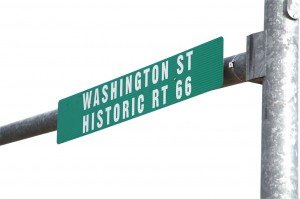
Sign at the Hwy. 19 (Franklin St.)/Route 66 (Washington) intersection
A colorful, but somewhat confusing, intersection in Cuba, Missouri got some new direction with the installation of dual signage.
After Route 66 tourists and others were confused with the existing sign in the center of the Route 66 community of Cuba, Missouri, the city and MoDOT agreed on the use of signs that paid tribute to a dual legacy. While the street is part of historic Route 66, it is also known locally as Washington. The sign now says both “Washington” and “Historic Route 66.”
The colorful intersection is the home of a restored Phillips 66 gas station from the 1930s, one of Cuba’s, “Route 66 Mural City,” murals, painted traffic control boxes, and the location of the Viva Cuba Garden with an 1873 train replica.
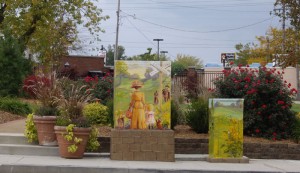
The traffic control boxes complement the train sculpture in the newly landscaped garden.
Wallis Companies owns and restored the old Phillips station.Their headquarters sits across from the station in a modern, buff-colored brick building. The company’s first office in 1968 was located in the small station across the street. Today, the company owns a chain of convenience stores and is one of the Midwest’s largest distributors of petroleum products and has over 600 employees. The founder of the company Bill Wallis passed away in 2001, but his wife and children still run the company. The three mural panels on the original company headquarters portray events in the life of Bill Wallis and the Cuba community. Route 66 Missouri artist Ray Harvey painted the murals.
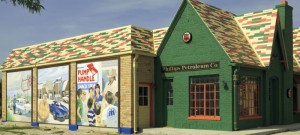
The restored Phillips 66 Station was built by Paul T. Carr. It now displays scenes from the intersection and Route 66.
The Viva Cuba Garden, first purchased in 1992, was re-designed and landscaped in 2007-08 by Viva Cuba, a community beautification group that commissioned Cuba’s 12 outdoor murals. The replica train, built by Curtis and Glen Tutterrow, was added in 2008 to commemorate a train that ran between Cuba and Salem, MO. Missouri artist Julie Wiegand painted the nearby traffic control boxes in 2008 just before Viva Cuba re-dedicated the park.
The large white structure on the fourth corner of the intersection is the old Midway Building that has been a presence since the 1930s. It was named because it was midway between St. Louis and Springfield. While the building is now empty, it has a rich history that is revered by the community. For years it was a bus stop, taxi stand, hotel, cafeteria, gathering place for families, and a nightspot.
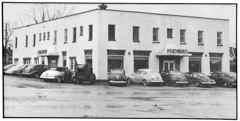
A 1948 image of Midway shows the business at its peak.
Allyne Earls owned Midway for 38 years, and the doors were never locked. When she sold the building, no keys could be found to give the new owner. During WW II, the it had 24 bedrooms and four bathrooms on the second floor. During the War, they were filled with Fort Leonard Wood soldiers and their wives. The restaurant fed as many as 600 soldiers a day. Over the years, families celebrated at the Midway, and teenagers met to dance and socialize. In the 1970s, hockey star Noel Picard owned the restaurant and bar. Today, the building awaits someone with a new vision to reenergize the old landmark.
Update: The Midway building has been demolished and is now an empty lot. Several blogs deal with the Midway’s history with photos and details.
When travelers see the new sign, they might reflect on the history of the spot as they journey through the historic intersection.
UPDATE: Read “Cuba, Missouri says goodby to long time trooper and a piece of our history….”
Read “Revisiting the Route 66 and Highway 19 intersection…now and then.”
Read ” Do you remember? Standing at the 4-way on Route 66 in 2006…”
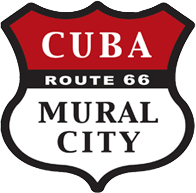


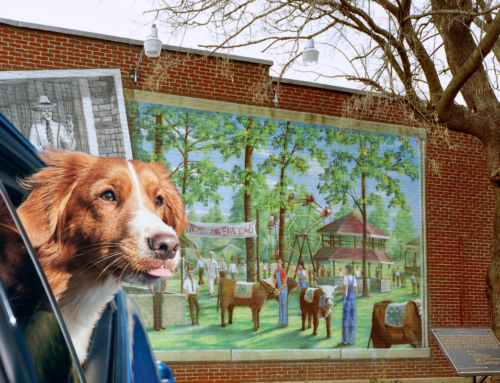

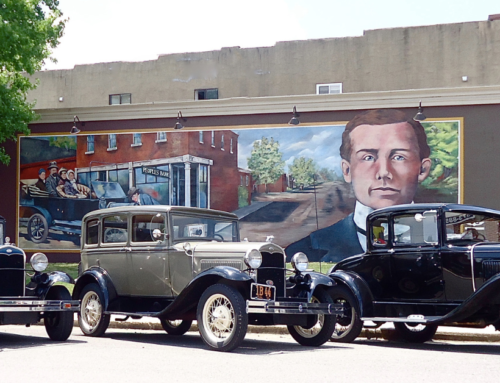

When the new T shirts are ready, I am interested in purchasing two, 1 2XL and 1 XL. Please let me know the cost and the procedure to purchase these shirts. Cuba is my home town, but I have lived in Michigan 45 years, and now winter in Florida. My family still live there in Cuba and Crawford County. I love my Missouri roots!
Thank you for your loyalty to Cuba. We will keep you posted on the shirts. I guess Cuba is a state of mind and not just a location.
Cuba is my home town too. Love all the stories about Cuba and Midway .
Thanks for reading our blogs. It is gratifying when homeowners follow Cuba and share their feelings.
I will plan to trip on Route 66 on July 2012
We hope that you can stay at our Wagon Wheel Motel and visit some of our attractions.
I am the grandson of Blanche Rook who worked for Allyne Earls as a cashier at The Midway for many years in the 40’s, 50’s & 60’s. I remember fondly playing all over Cuba and up and down Rt 66. I especially remember a walkway/pedestrian tunnel that ran under Rt.66. Last visit to Cuba I could not find the tunnel or remember the exact location. Do you know what corner of Rt.66 this was on and when it was filled in? Also, I hear that The old Midway building is due to be demolished. Has this been done yet?
Thank you for commenting. The overpass was at the corner of Smith and Washington/Route 66. If you go here https://cubamomurals.com/wordpress/2011/07/cuba-missouri-route-66-landmark-underpass-gone-but-not-forgotten/
you can find a blog on the overpass and photos.
The Midway has pretty much been gutted but not torn down yet. Also go to the Part I History of Midway: https://cubamomurals.com/wordpress/2011/12/cuba-missouri-good-by-midway-part-i/
and for a followup visit : https://cubamomurals.com/wordpress/2012/01/some-midway-match-ups-stand-the-test-of-time/. There are old photos on both blogs.
Do you have any old family photos of the Midway?
can anyone let me know about my aunt nellie merhoff/capehart? she lived off of hwy pp past the old Voss Skelly truck stop
Her children still live in the area. Her brother Bill Capehart still lives in Cuba.
A native of nearby Steelville, during 1963-1965 I would go to the drive-in movie on 19 North and after the show we would congregate at the Midway Cafe for cokes and visit. A lot of fun, a lot of memories, and I personally knew Allyne Earls.
There are several posts on the blog about the Midway. There is Part I and Part II posts that you might like. Please Share our blog with others that might like to read of some of the old places in Cuba. Also, you can visit our Facebook page Cuba MO Murals & More for updated photos and info on Cuba and the area. Thanks for stopping by.
I always stop in Cuba when driving 44 through Missouri.The small town has it all,antique ,good food,paintings on buildings,nice people.The Wagon Wheel is the place to stay.Walking around town and taking your time is the way to go.Its in a nice location and a short trip to many things to do.Some day soon it just might be my retirement home.A place that’s really cares and takes time to make you feel welcome.
Thanks for your kind comments. May we ask what attracted you to Cuba originally and what state that you live in now?